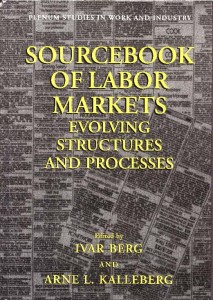Ivar Berg and Arne L. Kalleberg (editors). 2001. Sourcebook of Labor Markets: Evolving Structures and Processes. New York: Kluwer/Plenum. ISBN: 0-306-46453-5 (cloth).
 This comprehensive handbook provides an overview of the key developments in a variety of labor market contexts and in the analyses of these that have occurred during the two decades since the publication of the groundbreaking 1981 volume Sociological Perspectives on Labor Markets. A distinguished roster of authors (sociologists as well as economists) examines the interplay between social institutions and markets in producing important outcomes for producers of goods and services, their organizations’ owners, and their customers. For example, the authors investigate how social institutions such as unions, business organizations, and the government interact with labor, product, political, and capital markets to produce a variety of labor market outcomes, widening income inequality, career paths, and a variety of changing employment relationships.
This comprehensive handbook provides an overview of the key developments in a variety of labor market contexts and in the analyses of these that have occurred during the two decades since the publication of the groundbreaking 1981 volume Sociological Perspectives on Labor Markets. A distinguished roster of authors (sociologists as well as economists) examines the interplay between social institutions and markets in producing important outcomes for producers of goods and services, their organizations’ owners, and their customers. For example, the authors investigate how social institutions such as unions, business organizations, and the government interact with labor, product, political, and capital markets to produce a variety of labor market outcomes, widening income inequality, career paths, and a variety of changing employment relationships.
In addition to introductory and concluding chapters by the editors, the volume contains 25 chapters covering key topics in the field. The sourcebook is divided into four substantive sections, each of which is introduced by a summary statement discussing the section’s theme. Part II examines the changes taking place in unions and the industrial relations system; the allocation of risk between capital and labor; capital accumulation; and how labor markets are being transformed in post-Communist Europe. Part III addresses changes that are occurring in the nature of employment relations, such as in the careers and the attachment of people to their jobs. Part IV focuses on trends in income inequality and job quality, the nature of education and workforce development, the role of networks in matching people to jobs, and regional labor markets. Part V examines the implications of labor market changes for public policies related to topics such as comparable worth, employment discrimination by race and sex, and immigration.
These chapters provide timely assessments of the key developments that are occurring in each of these topics related to labor markets. The authors provide an interdisciplinary perspective on the correlates and consequences of labor market structures and processes, assessing what we know about these topics and what areas need to be understood better.
CONTENTS:
I. Introduction
1. Emerging Labor Market Structures: Contexts and Correlates; I. Berg, A.L. Kalleberg.
II. Evolving Markets and Institutional Structures
2. Risk and the Labor Market: Societal Past as Economic Prologue; S.M. Jacoby.
3. The U.S. Labor Movement: Toward a Sociology of Labor Revitalization; D.B. Cornfield, B. Fletcher.
4. Can the U.S. Industrial Relations System be Transformed? The Role of Ideas, Reform Efforts, and Social Crisis; T.A. Kochan.
5. The Next Long Swing: Spatialization, Technocratic Control, and the Restructuring of Work at the Turn of the Century; M.Wallace, D. Brady.
6. Labor Markets and Economic Transformation in Post-Communist Europe; R. Jenkins.
III. Evolving Employment Relations and Work Structures
7. Employment Relations and Work Structures and the Return to Huddersfield; I. Berg.
8. Evolving Employment Relations in the United States; A.L. Kalleberg.
9. Assessing the Decline of Internal Labor Markets; P. Cappelli.
10. The Loose Coupling of Jobs: The Subcontracting of Everyone? N. DiTomaso.
11. High-Performance Work Systems and Labor Market Structures; E. Appelbaum, P. Berg.
12. Careers and Employment Relations; A.B. Sorensen.
13. Age and the Labor Market: Trends in Employment Security and Employment Institutions; W.P. Bridges.
IV. Evolving Patterns of Stratification in the United States
14. Trends in Income Inequality in the United States; F. Nielsen, A.S. Aldersen.
15. Did Job Quality Deteriorate in the 1980s and 1990s? J. Schmitt.
16. Six Reasons for Skepticism about the Technology Story of U.S. Wage Inequality; J.
Bernstein, L. Mishel.
17. Changing Labor Markets and the U.S. Workforce Development System; T. Bailey.
18. What Happened to Middle Management? M.W. Meyer.
19. Social Networks, Job Changes, and Recruitment; P.V. Marsden, E.H. Gorman.
20. Regional Labor Markets; J.J. Beggs, W.J. Villemez.
V. Evolving Public Policies: Structure of Opportunity and Economic Outcomes
21. Evolving Patterns of Sex Segregation; J.A. Jacobs.
22. The Sex Gap in Pay and Comparable Worth: An Update; P. England, J. Thompson, C. Aman.
23. Employment Discrimination and its Remedies; B.F. Reskin.
24. Hiring in Urban Labor Markets: Shifting Labor Demands, Persistent Racial Differences; P. Moss, C. Tilly.
25. Race and Labor Market Segmentation; R.L. Kaufman.
26. Immigration and Labor Markets in the United States; F.D. Bean, S. Gonzalez-Baker, R. Capps.
VI. Afterword
27. Evolving Labor Markets: Conclusions and Implications; I. Berg, A. Kalleberg.
Please find book reviews here.
Click Here to buy book.